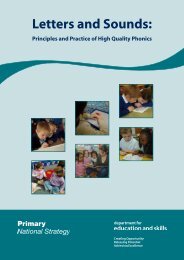Free download of:Excellence in English - Department for Education
Free download of:Excellence in English - Department for Education
Free download of:Excellence in English - Department for Education
Create successful ePaper yourself
Turn your PDF publications into a flip-book with our unique Google optimized e-Paper software.
<strong>in</strong>dividual whiteboards, pupils suggested and evaluated descriptive words and<br />
phrases <strong>for</strong> the various moods created by the music. The teacher’s open<br />
questions encouraged them to reflect on the l<strong>in</strong>ks between sounds, images and<br />
language, to draw <strong>in</strong>ferences and make predictions. Good use was made <strong>of</strong> the<br />
classroom’s ‘writ<strong>in</strong>g wall’, to which pupils had earlier contributed descriptive<br />
vocabulary.<br />
50. Some pupils were slow to volunteer ideas at this stage. They could, however,<br />
be seen actively contribut<strong>in</strong>g to discussion a little later when work<strong>in</strong>g <strong>in</strong> small<br />
groups to <strong>in</strong>terpret characters’ develop<strong>in</strong>g relationships and the author’s<br />
<strong>in</strong>tentions <strong>in</strong> the illustrations. When pupils then shared their th<strong>in</strong>k<strong>in</strong>g with the<br />
whole class, role play and hot-seat<strong>in</strong>g clearly helped them to be specific and to<br />
dig deep <strong>in</strong>to motivation, mood and po<strong>in</strong>t <strong>of</strong> view. It was noticeable that far<br />
more pupils were able to contribute productively to the f<strong>in</strong>al discussion than<br />
had been the case at the beg<strong>in</strong>n<strong>in</strong>g <strong>of</strong> the lesson. Their <strong>in</strong>volvement and<br />
learn<strong>in</strong>g had been developed through approaches that <strong>in</strong>cluded visual, musical<br />
and l<strong>in</strong>guistic strategies.<br />
51. In discussion, pupils were emphatic that the th<strong>in</strong>k<strong>in</strong>g and analysis prompted by<br />
this approach to read<strong>in</strong>g had a positive impact on their writ<strong>in</strong>g: ‘It makes you<br />
more imag<strong>in</strong>ative.’ They drew on the ideas and strategies that they had<br />
identified through their analysis <strong>of</strong> visual texts. Their extended writ<strong>in</strong>g was<br />
<strong>of</strong>ten imag<strong>in</strong>ative, vividly descriptive and carefully plotted. This was<br />
demonstrated <strong>in</strong> work sparked by exploration <strong>of</strong> the open<strong>in</strong>g sequences <strong>in</strong> The<br />
arrival. Boys as well as girls enjoyed build<strong>in</strong>g up suspense and an atmosphere<br />
<strong>of</strong> menace, try<strong>in</strong>g out <strong>for</strong> themselves Shaun Tan’s device <strong>of</strong> half-seen,<br />
suggestive glimpses <strong>of</strong> ‘th<strong>in</strong>gs’ that create unease. Those whose grasp <strong>of</strong><br />
<strong>English</strong> made extended writ<strong>in</strong>g difficult were able to develop and organise their<br />
ideas as a captioned poster or storyboard.<br />
52. The explicit development <strong>of</strong> pupils’ speak<strong>in</strong>g and listen<strong>in</strong>g skills is also key to<br />
achievement <strong>in</strong> a school where <strong>English</strong> is an additional language <strong>for</strong> most<br />
pupils. Teach<strong>in</strong>g <strong>in</strong> <strong>English</strong> is characterised by a dist<strong>in</strong>ct and well-developed<br />
approach to group work. The school has replaced the more common primary<br />
school policy <strong>of</strong> guided read<strong>in</strong>g with a group read<strong>in</strong>g programme which it has<br />
adapted to suit the needs <strong>of</strong> its pupils. The pr<strong>in</strong>ciple beh<strong>in</strong>d this approach is<br />
that shar<strong>in</strong>g observations and <strong>in</strong>terpretations enhances what any pupil can do<br />
<strong>in</strong>dividually: ‘You have more fun. You look closely and see th<strong>in</strong>gs you didn’t<br />
notice be<strong>for</strong>e.’ Pupils describe this approach as ‘giv<strong>in</strong>g and receiv<strong>in</strong>g’. Central to<br />
the programme is that children th<strong>in</strong>k <strong>of</strong> their own questions to discuss with<br />
their peers. This develops read<strong>in</strong>g comprehension alongside <strong>in</strong>dependence and<br />
th<strong>in</strong>k<strong>in</strong>g skills.<br />
53. One lesson observed showed how teachers managed this approach to group<br />
work on a class novel. The different activities were as follows. One group was<br />
led by a pupil selected by the other pupils. This was a productive exercise <strong>in</strong><br />
enlightened decision-mak<strong>in</strong>g: ‘We’re not judg<strong>in</strong>g people. We choose a leader to<br />
be happy. We give a turn to everybody.’ As pupils took turns to read aloud, the<br />
<strong>Excellence</strong> <strong>in</strong> <strong>English</strong>: what we can learn from 12 outstand<strong>in</strong>g schools<br />
May 2011, No. 100229<br />
21
















